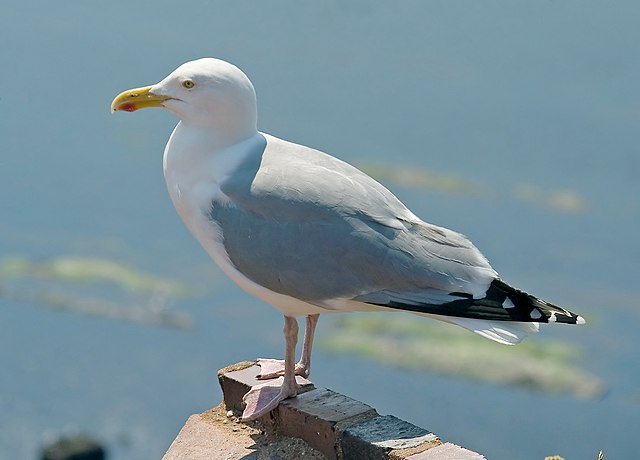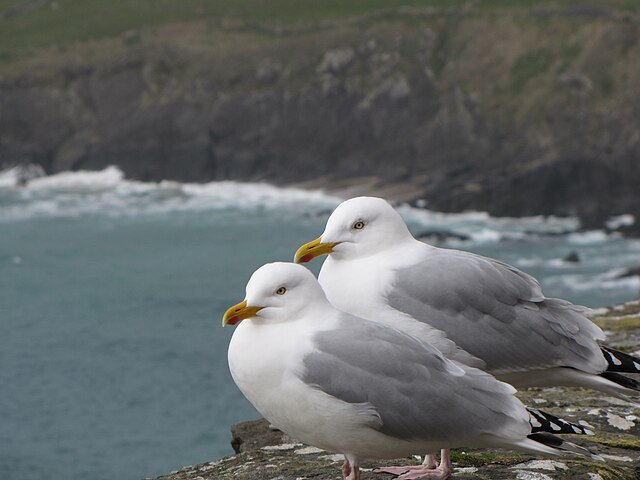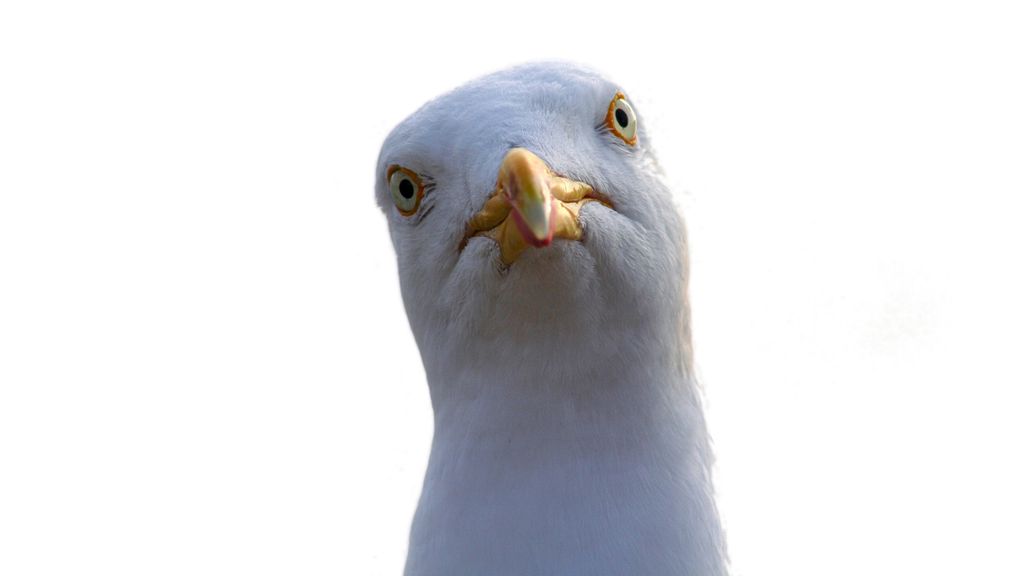Post by Eaglehawk on Aug 9, 2019 5:02:40 GMT
European Herring Gull - Larus argentatus

Scientific classification
Kingdom: Animalia
Phylum: Chordata
Class: Aves
Order: Charadriiformes
Family: Laridae
Genus: Larus
Species: Larus argentatus
The European herring gull (Larus argentatus) is a large gull, up to 26 in (66 cm) long. One of the best-known of all gulls along the shores of Western Europe, it was once abundant. It breeds across Northern Europe, Western Europe, Central Europe, Eastern Europe, Scandinavia, and the Baltic states. Some European herring gulls, especially those resident in colder areas, migrate further south in winter, but many are permanent residents, e.g. in Ireland, Britain, Iceland, or on the North Sea shores. They have a varied diet, including fish, crustaceans, and dead animals, as well as some plants.
While herring gull numbers appear to have been harmed in recent years, possibly by fish population declines and competition, they have proved able to survive in human-adapted areas and can often be seen in towns acting as scavengers.
Subspecies
L. a. argentatus – Pontoppidan, 1763, the nominate form, sometimes known as the Scandinavian Herring Gull, breeds in Scandinavia and north-west Russia. Northern and eastern populations migrate south-west in winter. It is a large, bulky gull with extensive white in the wingtips.
L. a. argenteus – Brehm & Schilling, 1822, sometimes known as the Western European Werring Gull breeds in Western Europe in Iceland, the Faroes, Britain, Ireland, France, Belgium, the Netherlands and Germany. Many birds are resident while others make short-distance migratory journeys. It is smaller than L. a. argentatus with more black and less white in the wingtips and paler upper parts.
These taxa are classified as subspecies of Larus argentatus by some authorities such as the American Ornithologists' Union and Handbook of the Birds of the World. Others such as the Association of European Rarities Committees and British Ornithologists' Union now regard them as one or two separate species.
L. (a.) smithsonianus, American Herring Gull, breeds in Alaska, Canada, and the Northeast United States. Many birds migrate southwards in winter, reaching as far as Central America and the West Indies. Immature birds tend to be darker and more uniformly brown than European herring gulls and have a dark tail.
L. (a.) vegae, the Vega Gull, breeds in north-east Siberia. It winters in Japan, Korea, eastern China, and Taiwan.
Several other gulls have been included in this species in the past, but are now normally considered separate, e.g. Yellow-legged Gull (L. michahellis), Caspian Gull (L. cachinnans), Armenian Gull (L. armenicus) and Heuglin's Gull (L. heuglini).

Description
Size: 56-66 cm (22-26 in)
Wingspan: 137-146 cm (54-57 in)
Weight: 800-1250 g (28.24-44.13 ounces)
Medium to large gull.
Head and underparts white.
Back light gray.
Wingtips black with white spots.
Bill yellow with red spot near tip of lower mandible.
Breeding (Alternate) Plumage: Head, neck, and underparts pure white. Back and wings light gray. Legs dull pink. Eyes golden. Yellow or orange ring of skin around eyes. Bill yellow with red spot. Underside of wingtip black to silver.
Nonbreeding (Basic) Plumage: Head and sides of breast variably streaked with dusky, sometimes forming a dirty hood.
Sex Differences
Sexes alike in plumage, male larger than females.
Immature

Juvenal plumage: Dark brown head and body, face and nape paler. Blackish around eye. Back and wings gray-brown with light edgings to feathers. Tail with large black band, whitish and barred at base. Flight feathers on wing blackish. Inner primaries pale with dark tips, forming pale window in spread wings. Bill black with pale base. Legs dark gray with pink overtones. Eyes dark brown.
First Winter (Basic I):
Like juvenal, but head, throat, and breast whiter and back feathers with more complex pattern of bars. Bill black with base becoming paler. Eyes dark brown.
First Summer (Alternate I):
Head, neck, and especially the throat whiter, but still streaked. Back showing a few light gray feathers. Wing feathers worn and paler. Bill black with pale base. Eyes dark brown.
Second Winter (Basic II):

Head whiter, but neck heavily streaked. Back mottled brown and light gray. Underparts and rump mostly white, with variable amount of dark streaking. Wing tips black. Inner wings gray with variable amount of brown barring. Underwing whiter. Tail white at base with variable broad blackish subterminal band. Bill pale flesh at base, then black, with small white tip. Eyes pale straw or brown. Legs pale pinkish.
Second Summer (Alternate II):
Head and neck largely white. Back may be entirely light gray with a few brown feathers. Underparts mostly white, with some streaking in throat. Bill yellowish at base, then black with white tip. Eyes pale straw or brown.
Third Winter (Basic III):

Extensive dusky streaking on otherwise white head and neck, and especially around eye. Back light gray. Underparts white. Tail largely white with variable dark markings. Outer wing feathers (primaries) black with white tips, with white subterminal spots on some. Inner wing feathers with variable amount of brown markings. Underwing white with gray trailing edge and black tips to outer primaries. Bill yellowish with blackish bar or spots behind nostrils. Eyes yellow or buff.
Third Summer (Alternate III):
Head and neck pure white or with only little streaking. Back all gray. Underparts white. Tail white with some dark smudging. Bill yellow with some red on lower mandible. Eyes brighter yellow. Legs brighter pink.
Similar Species
Ring-billed Gull smaller, with yellow legs in adult and distinct black ring around bill and no red spot. Immature Ring-billed Gull with thinner black band on tail.
Thayer's Gull very similar, but adult has dark eyes and lacks most of the black under the wingtip.
California Gull is smaller, has yellowish green legs, and a black spot in front of the red spot on the bill.
Sound
Calls are loud, clear bugling.
Range

Approximate distribution of European Herring Gull (Larus argentatus). Green: year-round, yellow: breeding, blue: wintering.
Habitat
Breeds on islands.
Forages and winters at sea, along beaches and mudflats, at dumps, and other areas where human-produced food is available.
Rests in open areas, including parking lots, fields, and airports.
Behaviour
Herring Gull flocks have a loose pecking order, based on size, aggressiveness and physical strength. Communication between these birds is complex and highly-developed - employing both calls and body language. Two identical vocalizations can have very different (sometimes opposite) meanings, for example - depending on the positionings of the head, body, wings and tail relative to each other and the ground in the calling gull.
Unlike many flocking birds, Herring Gulls do not engage in social grooming and keep physical contact between individuals to a minimum. Outside of the male/female and parent/chick relationship, each Herring Gull attempts to maintain a respectful 'safe distance' from others of its kind. Any breach of this results in fighting, though severe injuries are seldom inflicted.
Herring Gulls are known to be capable of seeing ultraviolet light.
Parasites of Herring gulls include the fluke Microphallus piriformes.
Diet
These are omnivores like most Larus gulls, and will scavenge on rubbish tips and elsewhere, as well as seeking suitable small prey in fields or on the coast, or robbing plovers or lapwings of their catches. Despite their name, they have no special preference for herrings.
Reproduction
Two to four eggs, usually three, are laid on the ground or cliff ledges in colonies, and are defended vigorously by this large gull. The eggs are a dark blotched, olive color. They are incubated for 28-30 days.
Juveniles use their beaks to "knock" on the red spot on the beaks of adults to indicate hunger. Parents typically disgorge food for their offspring when they are "knocked". The young birds are able to fly 35-40 days after hatching.
Conservation Status
Hunting for the millinery trade nearly extirpated it from parts of range in 1800s. It has come back to historic high population levels in some areas, and is extending its breeding range southward.
Other Names
Goéland argenté (French)
Gaviota plateada, Apipizca (Spanish)

Cool Facts

Scientific classification
Kingdom: Animalia
Phylum: Chordata
Class: Aves
Order: Charadriiformes
Family: Laridae
Genus: Larus
Species: Larus argentatus
The European herring gull (Larus argentatus) is a large gull, up to 26 in (66 cm) long. One of the best-known of all gulls along the shores of Western Europe, it was once abundant. It breeds across Northern Europe, Western Europe, Central Europe, Eastern Europe, Scandinavia, and the Baltic states. Some European herring gulls, especially those resident in colder areas, migrate further south in winter, but many are permanent residents, e.g. in Ireland, Britain, Iceland, or on the North Sea shores. They have a varied diet, including fish, crustaceans, and dead animals, as well as some plants.
While herring gull numbers appear to have been harmed in recent years, possibly by fish population declines and competition, they have proved able to survive in human-adapted areas and can often be seen in towns acting as scavengers.
Subspecies
L. a. argentatus – Pontoppidan, 1763, the nominate form, sometimes known as the Scandinavian Herring Gull, breeds in Scandinavia and north-west Russia. Northern and eastern populations migrate south-west in winter. It is a large, bulky gull with extensive white in the wingtips.
L. a. argenteus – Brehm & Schilling, 1822, sometimes known as the Western European Werring Gull breeds in Western Europe in Iceland, the Faroes, Britain, Ireland, France, Belgium, the Netherlands and Germany. Many birds are resident while others make short-distance migratory journeys. It is smaller than L. a. argentatus with more black and less white in the wingtips and paler upper parts.
These taxa are classified as subspecies of Larus argentatus by some authorities such as the American Ornithologists' Union and Handbook of the Birds of the World. Others such as the Association of European Rarities Committees and British Ornithologists' Union now regard them as one or two separate species.
L. (a.) smithsonianus, American Herring Gull, breeds in Alaska, Canada, and the Northeast United States. Many birds migrate southwards in winter, reaching as far as Central America and the West Indies. Immature birds tend to be darker and more uniformly brown than European herring gulls and have a dark tail.
L. (a.) vegae, the Vega Gull, breeds in north-east Siberia. It winters in Japan, Korea, eastern China, and Taiwan.
Several other gulls have been included in this species in the past, but are now normally considered separate, e.g. Yellow-legged Gull (L. michahellis), Caspian Gull (L. cachinnans), Armenian Gull (L. armenicus) and Heuglin's Gull (L. heuglini).

Description
Size: 56-66 cm (22-26 in)
Wingspan: 137-146 cm (54-57 in)
Weight: 800-1250 g (28.24-44.13 ounces)
Medium to large gull.
Head and underparts white.
Back light gray.
Wingtips black with white spots.
Bill yellow with red spot near tip of lower mandible.
Breeding (Alternate) Plumage: Head, neck, and underparts pure white. Back and wings light gray. Legs dull pink. Eyes golden. Yellow or orange ring of skin around eyes. Bill yellow with red spot. Underside of wingtip black to silver.
Nonbreeding (Basic) Plumage: Head and sides of breast variably streaked with dusky, sometimes forming a dirty hood.
Sex Differences
Sexes alike in plumage, male larger than females.
Immature

Juvenal plumage: Dark brown head and body, face and nape paler. Blackish around eye. Back and wings gray-brown with light edgings to feathers. Tail with large black band, whitish and barred at base. Flight feathers on wing blackish. Inner primaries pale with dark tips, forming pale window in spread wings. Bill black with pale base. Legs dark gray with pink overtones. Eyes dark brown.
First Winter (Basic I):
Like juvenal, but head, throat, and breast whiter and back feathers with more complex pattern of bars. Bill black with base becoming paler. Eyes dark brown.
First Summer (Alternate I):
Head, neck, and especially the throat whiter, but still streaked. Back showing a few light gray feathers. Wing feathers worn and paler. Bill black with pale base. Eyes dark brown.
Second Winter (Basic II):

Head whiter, but neck heavily streaked. Back mottled brown and light gray. Underparts and rump mostly white, with variable amount of dark streaking. Wing tips black. Inner wings gray with variable amount of brown barring. Underwing whiter. Tail white at base with variable broad blackish subterminal band. Bill pale flesh at base, then black, with small white tip. Eyes pale straw or brown. Legs pale pinkish.
Second Summer (Alternate II):
Head and neck largely white. Back may be entirely light gray with a few brown feathers. Underparts mostly white, with some streaking in throat. Bill yellowish at base, then black with white tip. Eyes pale straw or brown.
Third Winter (Basic III):

Extensive dusky streaking on otherwise white head and neck, and especially around eye. Back light gray. Underparts white. Tail largely white with variable dark markings. Outer wing feathers (primaries) black with white tips, with white subterminal spots on some. Inner wing feathers with variable amount of brown markings. Underwing white with gray trailing edge and black tips to outer primaries. Bill yellowish with blackish bar or spots behind nostrils. Eyes yellow or buff.
Third Summer (Alternate III):
Head and neck pure white or with only little streaking. Back all gray. Underparts white. Tail white with some dark smudging. Bill yellow with some red on lower mandible. Eyes brighter yellow. Legs brighter pink.
Similar Species
Ring-billed Gull smaller, with yellow legs in adult and distinct black ring around bill and no red spot. Immature Ring-billed Gull with thinner black band on tail.
Thayer's Gull very similar, but adult has dark eyes and lacks most of the black under the wingtip.
California Gull is smaller, has yellowish green legs, and a black spot in front of the red spot on the bill.
Sound
Calls are loud, clear bugling.
Range

Approximate distribution of European Herring Gull (Larus argentatus). Green: year-round, yellow: breeding, blue: wintering.
Habitat
Breeds on islands.
Forages and winters at sea, along beaches and mudflats, at dumps, and other areas where human-produced food is available.
Rests in open areas, including parking lots, fields, and airports.
Behaviour
Herring Gull flocks have a loose pecking order, based on size, aggressiveness and physical strength. Communication between these birds is complex and highly-developed - employing both calls and body language. Two identical vocalizations can have very different (sometimes opposite) meanings, for example - depending on the positionings of the head, body, wings and tail relative to each other and the ground in the calling gull.
Unlike many flocking birds, Herring Gulls do not engage in social grooming and keep physical contact between individuals to a minimum. Outside of the male/female and parent/chick relationship, each Herring Gull attempts to maintain a respectful 'safe distance' from others of its kind. Any breach of this results in fighting, though severe injuries are seldom inflicted.
Herring Gulls are known to be capable of seeing ultraviolet light.
Parasites of Herring gulls include the fluke Microphallus piriformes.
Diet
These are omnivores like most Larus gulls, and will scavenge on rubbish tips and elsewhere, as well as seeking suitable small prey in fields or on the coast, or robbing plovers or lapwings of their catches. Despite their name, they have no special preference for herrings.
Reproduction
Two to four eggs, usually three, are laid on the ground or cliff ledges in colonies, and are defended vigorously by this large gull. The eggs are a dark blotched, olive color. They are incubated for 28-30 days.
Juveniles use their beaks to "knock" on the red spot on the beaks of adults to indicate hunger. Parents typically disgorge food for their offspring when they are "knocked". The young birds are able to fly 35-40 days after hatching.
Conservation Status
Hunting for the millinery trade nearly extirpated it from parts of range in 1800s. It has come back to historic high population levels in some areas, and is extending its breeding range southward.
Other Names
Goéland argenté (French)
Gaviota plateada, Apipizca (Spanish)

Cool Facts



